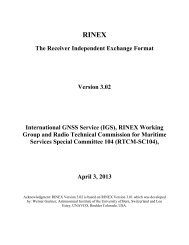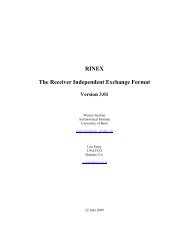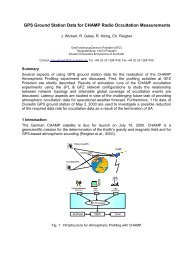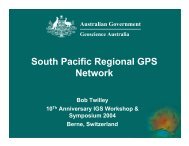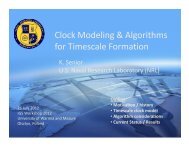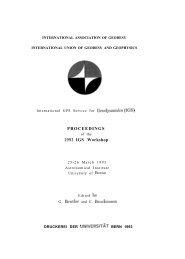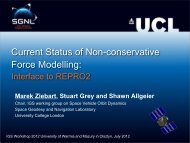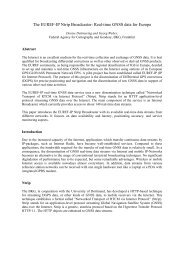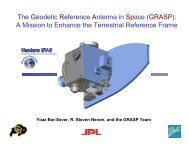IGS Analysis Center Workshop - IGS - NASA
IGS Analysis Center Workshop - IGS - NASA
IGS Analysis Center Workshop - IGS - NASA
You also want an ePaper? Increase the reach of your titles
YUMPU automatically turns print PDFs into web optimized ePapers that Google loves.
Summary InformationThe third product offered by all <strong>Center</strong>s is the sum file. Shown in Table 4 is a summary of the kindsof information contained in this file, by <strong>Center</strong>. The categorization is subjective, of course.Of the three product categories - precise orbits, earth orientation, and summary - the last shows theleast uniformity among <strong>Center</strong>s, as the Table 4 clearly shows.The following four categories are included by a majority of <strong>Center</strong>s in their sum files: productsummary, remarks, and station summary and orbit quality. Of these, there is considerable variationin the orbit quality metric, which for the most part is a measure of orbit continuity from day to day.Table 4.Information in . sum File, by <strong>Analysis</strong> <strong>Center</strong>key: o => included => excludedCOD EMR ESA GFZ JPL NGS S10 totalproduct summary o 0 0 0 0 . 0remarks o 0 0 0 0 . 0station summary o 0 0 0 0 . 0orbit quality o . 0 0 0 0earth orientation . . 0 0 . 0solution characteristics . 0 0 0 . .solution statistics o . 0 . 0 .length of day . 0 0 .station coordinatesobaseline coordinates . . . 066653332113. Core StationsBased on the sum files submitted for GPS week 713 (93 Sep 5-11 ), Table 5 indicates stations fromwhich data are used as function of <strong>Center</strong>. Included stations are indicated by either a “*” or “o”,depending on whether the station coordinates are fixed or estimated, respectively. Note that themeaning of “fixed” is not necessarily the same for all <strong>Center</strong>s, and can range from truly fixed(constrained absolutely to the apriori values) to an a priori constraint of 2 cm.The distribution of the “total” column in Table 5 is shown in Figure 1. Thus nine of the sites areanalyzed by only one <strong>Center</strong>, eight are analyzed by exactly two <strong>Center</strong>s, and so on, until we cometo nine sites analyzed by all seven <strong>Analysis</strong> <strong>Center</strong>s.11




